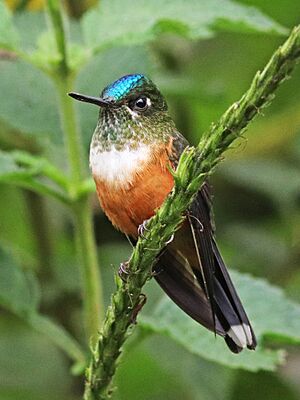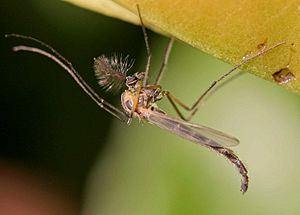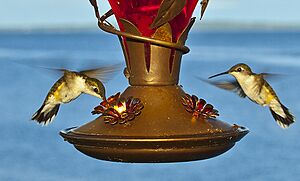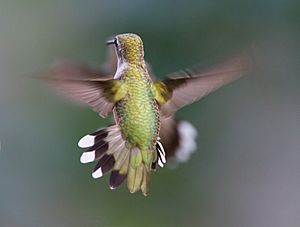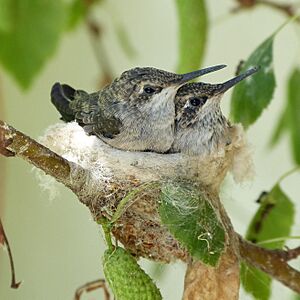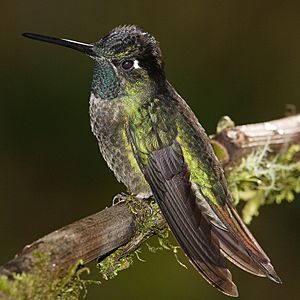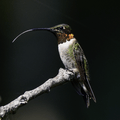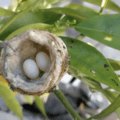Hummingbird facts for kids
Quick facts for kids Hummingbird |
|
|---|---|
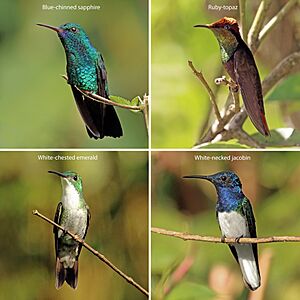 |
|
| Four hummingbirds from Trinidad and Tobago |
|
| Scientific classification |
|
| Kingdom: | Animalia |
| Phylum: | Chordata |
| Class: | Aves |
| Order: | Apodiformes |
| Family: | Trochilidae Vigors, 1825 |
| Type genus | |
| Trochilus Linnaeus, 1758
|
|
| Subfamilies | |
|
Subfamilies:
†Eurotrochilus
Florisuginae Phaethornithinae Polytminae Lesbiinae Patagoninae Trochilinae (For an alphabetic species list, see List of hummingbird species) |
|
Hummingbirds are tiny, colorful birds belonging to the family Trochilidae. They are known for their amazing ability to hover in the air and fly backward.
These birds are among the smallest in the world. Most species are about 7.5 to 13 centimeters (3 to 5 inches) long. The smallest living bird is the Bee Hummingbird, which is only 2 to 5 centimeters long. Hummingbirds can flap their wings incredibly fast, from 12 to 80 times per second. This allows them to hover perfectly still. They can also fly very fast, over 54 kilometers per hour (34 miles per hour).
Contents
- What Hummingbirds Look Like
- Male and Female Differences
- Where Hummingbirds Live
- What Hummingbirds Eat
- Hummingbird Metabolism
- The Humming Sound
- How Hummingbirds Fly
- Hummingbird Sounds
- Reproduction and Life Cycle
- Hummingbird Migration
- How Long Hummingbirds Live
- Hummingbird Predators
- Hummingbird Populations
- Cool Facts About Hummingbirds
- Images for kids
- See also
What Hummingbirds Look Like
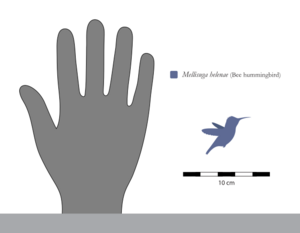

Hummingbirds have small, strong bodies. Their wings are long and shaped like blades. This special wing shape helps them fly like a helicopter, moving in any direction, even hovering.

Hummingbirds have short legs and small feet. Their feet have claws that help them grip onto flower stems or branches. Unlike most birds, hummingbirds do not walk or hop on the ground. They mostly use their feet for perching, cleaning their feathers, or building nests. They also use their feet to grab opponents during fights.
When hummingbirds take off, they use their legs to push themselves up. However, their short legs give them less power than other birds. While flying, hummingbirds tuck their feet close to their bodies. This helps them fly smoothly and move easily.
Male and Female Differences
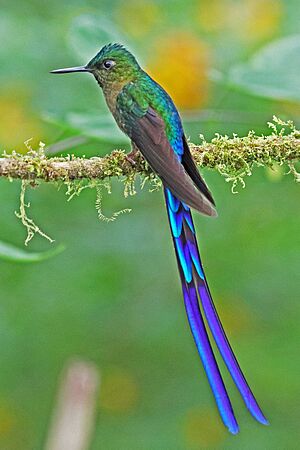
Male and female hummingbirds often look different. Males usually have brighter, more colorful feathers on their heads, necks, wings, and chests. A common feature on males is the gorget. This is a patch of shiny neck feathers that looks like a bib. It changes color depending on how you look at it. Males use their gorget to attract females and to warn other males to stay away from their area.
For birds of the same size, females tend to have longer beaks. Males are often smaller than females. Being smaller helps males save energy. This allows them to find food more easily and spend more time on courtship displays.
Female hummingbirds are usually larger and need more energy. Their longer beaks help them reach nectar deep inside tall flowers. This makes females better at finding food. It also helps them get enough energy for their larger bodies.
Where Hummingbirds Live
Hummingbirds live only in the Americas. You can find them from southern Alaska all the way down to Tierra del Fuego in South America, and also in the Caribbean. Most species live in warm, wet forests in Central and South America. Some species also live in cooler areas. Some hillstar hummingbirds even live high in the Andes mountains, up to 5,200 meters (17,000 feet) high!
The most different types of hummingbirds live in the Andes mountains. Many species are also found in the Atlantic Forest, Central America, and southern Mexico. Countries like Colombia have over 160 species, and Ecuador has about 130 species. In comparison, the United States has fewer than 25 species, and Canada and Chile each have fewer than 10.
What Hummingbirds Eat
Nectar from flowers is the main food source for hummingbirds. It gives them lots of energy. A hummingbird might visit one or two thousand flowers every day to get enough energy!
Nectar is great for energy, but it doesn't have all the nutrients hummingbirds need. It's low in fats and often lacks important amino acids (building blocks of protein). Even though hummingbirds don't need much protein, nectar alone isn't enough. So, hummingbirds also eat small insects and spiders to get the nutrients they need.
They often catch small flying insects in the air, like flies (especially midges). They also pick spiders from their webs. Hummingbirds with longer or more curved beaks might find it harder to catch insects in the air. So, they might eat more spiders.
Hummingbirds don't fly all day because it uses too much energy. Most of their time is spent sitting and resting. They eat many small meals throughout the day. They can eat about half their body weight in nectar every day! Because they are so small and have a fast metabolism, they digest their food very quickly, sometimes in less than an hour. Hummingbirds spend about 20% of their time eating and 75-80% sitting and digesting.
Because they need so much energy, hummingbirds are very good at finding food. Some species, especially in North America, protect their food sources, like a feeder. They try to keep other hummingbirds away to make sure they have enough food for themselves. Hummingbirds also have a special part of their brain that helps them remember where they found flowers before.
Hummingbird Feeders
In nature, hummingbirds get nectar from flowers. Nectar is mostly made of different kinds of sugar. People can also put out bird feeders with sugar water. This lets people watch hummingbirds up close. It also gives the birds a steady source of energy, especially when flowers are not blooming. However, if birds rely too much on feeders, they might visit fewer flowers. This means they might do less pollination, which is how plants make seeds.
A common recipe for hummingbird feeders is to mix white sugar with water. A good mix is about 20% sugar. Hummingbirds prefer sweeter nectar, so they might protect feeders more if the sugar content is higher. It's important to only use white granulated sugar. Other sugars like brown sugar, agave syrup, or honey can be harmful. Honey can spoil quickly and grow germs that can hurt the birds.
Some people used to think that adding red food dye to the sugar water was good. But it's not needed and can even be harmful. Commercial "hummingbird food" might have preservatives or artificial flavors and dyes. These are also unnecessary and could be bad for the birds. Hummingbirds get all the nutrients they need from the insects they eat, so they don't need extra nutrients in their sugar water.
Hummingbird Metabolism
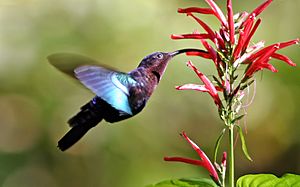
Hummingbirds have the fastest metabolism of all animals with backbones. This super-fast metabolism is needed to power their wings, which beat incredibly quickly during hovering and fast flight.
They are unique because they can use the sugar they just ate almost immediately to fuel their flight. They can use new sugars for hovering flight within 30 to 45 minutes of drinking them. By using new sugars for flying, hummingbirds save their stored fat. They use this fat to survive the night when they can't eat, or for long migratory flights.
For example, a ruby-throated hummingbird can fly 800 kilometers (500 miles) across the Gulf of Mexico without stopping. Before this long flight, it stores fat, sometimes doubling its body weight. This fat gives it the energy to fly over the open water. The amount of fat a hummingbird uses for this flight is like a human climbing about 15 meters (50 feet).
A hummingbird's heart rate can be incredibly high, up to 1,260 beats per minute! A blue-throated hummingbird was recorded with a heart rate of over 1,000 beats per minute and a breathing rate of 250 breaths per minute while resting.
Torpor: A Deep Sleep
Hummingbirds can slow down their metabolism at night or when there isn't enough food. This special ability is called torpor. It's like a deep sleep, similar to hibernation. How long and how often a hummingbird enters torpor depends on the species. Birds with more body fat are less likely to go into torpor. This is because they can use the energy from their fat stores. Torpor helps hummingbirds save energy, especially during cold nights.
During torpor at night, a Caribbean hummingbird's body temperature can drop from 40°C (104°F) to 18°C (64°F). Its heart rate and breathing slow down a lot. Its heart rate can go from over 1000 beats per minute during the day to only 50 to 180 beats per minute.
Surviving Winter
Anna's hummingbird lives in Seattle all year round. It can survive cold winters with freezing temperatures and snow. During cold weather, Anna's hummingbirds gain weight during the day by turning sugar into fat. If a hummingbird doesn't have enough fat or feathers, it can lower its metabolism and enter torpor to survive the cold.
The Humming Sound
The "humming" sound that gives these birds their name comes from their fast wingbeats. When their wings flap up and down quickly, they create air movements that make a sound like a musical instrument. This humming sound is special among flying animals. It's different from the whine of mosquitoes or the buzz of bees.
How Hummingbirds Fly
Scientists have studied hummingbird flight using special wind tunnels and high-speed video cameras. They found that hummingbirds create most of their lift (the force that keeps them in the air) during the downstroke of their wings. About 75% of the lift comes from the downstroke, and 25% from the upstroke. Their wings move in a figure-eight pattern.
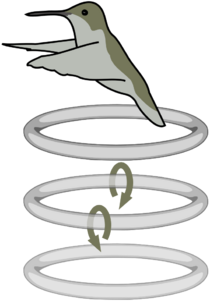
Earlier studies thought that hummingbirds created lift equally during both parts of the wingbeat. But this new finding shows that hummingbird hovering is similar to, but also different from, how insects like hawk moths hover.
The giant hummingbird's wings beat as few as 12 times per second. Most hummingbirds' wings beat up to 80 times per second. At higher altitudes, where the air is thinner, hummingbirds need more energy to hover. Hummingbird species that live in high places have larger wings. This helps them deal with the thinner air.
Slow-motion videos have shown how hummingbirds fly in the rain. To get water off their heads, they shake their heads and bodies, just like a dog. When raindrops are heavy, sometimes weighing as much as 38% of the bird's body weight, hummingbirds change how they fly. They move their bodies and tails horizontally, flap their wings faster, and change the angle of their wings.
Hummingbird Sounds
Many hummingbird species make different sounds like chirps, squeaks, whistles, and buzzes. They use these sounds to communicate with each other. They make different sounds when they are interacting with other birds, looking for food, defending their territory, trying to attract a mate, or talking to their babies.
The blue-throated hummingbird has a song that covers a very wide range of sounds. It can even make ultrasonic sounds that humans can't hear. Scientists think these ultrasonic clicks might disrupt insect flight patterns. This could make it easier for the hummingbirds to catch insects while singing.
Reproduction and Life Cycle
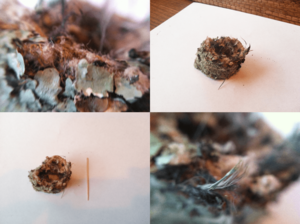
Male hummingbirds do not help with nesting or raising the young. Most species build a cup-shaped nest on a tree branch or bush. The size of the nest depends on the species. Some are smaller than half a walnut shell, while others are several centimeters wide.
Many hummingbirds use spider silk and lichen to hold their nests together. The spider silk is special because it can stretch. This allows the nest to grow bigger as the baby hummingbirds get larger. Females usually lay two tiny white eggs. Even though they are the smallest bird eggs, they are quite large compared to the adult hummingbird's size.
The mother bird sits on the eggs for 14 to 23 days. The time depends on the species, the temperature, and how much time the mother spends on the nest. The mother feeds her babies small insects and nectar. She puts her beak into the baby's mouth and brings up food from her crop. Baby hummingbirds stay in the nest for 18 to 22 days. After that, they leave the nest to find food on their own. However, the mother might still feed them for another 25 days.
Hummingbird Migration
Not all hummingbirds migrate. Out of about 366 known species, only about 12 to 15 species migrate every year.
Most North American hummingbirds fly south in the fall. They spend the winter in Mexico, the Caribbean Islands, or Central America. A few species live all year in Florida, California, and the southwestern desert regions of the US. These include Anna's hummingbird and the buff-bellied hummingbird. Ruby-throated hummingbirds are common along the Atlantic flyway. They fly from as far north as Atlantic Canada in the summer, and return to Mexico, South America, southern Texas, and Florida for winter.
The rufous hummingbird breeds farther north than any other hummingbird. It spends summers along the coast of British Columbia and Alaska. It winters in the southwestern United States and Mexico. Some even go to the coasts of the subtropical Gulf of Mexico and Florida. The rufous hummingbird travels a very long way and nests farther north than any other hummingbird. It can even handle temperatures below freezing in its breeding areas, as long as it has shelter and food.
The rufous hummingbird makes one of the longest journeys for any bird, especially when you compare it to its body size. These birds are just over 7.5 centimeters (3 inches) long. They travel about 6,300 kilometers (3,900 miles) one way from Alaska to Mexico in late summer. This distance is equal to 78,470,000 times their body length! Then they make the same trip back in the spring. For comparison, the 33-centimeter (13-inch) long Arctic tern flies about 18,000 kilometers (11,000 miles). This is only 51,430,000 times its body length, which is less than the rufous hummingbird's journey compared to its size.
The rufous hummingbird's journey north happens along the Pacific flyway. Their migration time might be linked to when flowers and tree leaves appear in early spring. It also depends on when insects are available for food. If they arrive at their breeding grounds before there is enough nectar, it could affect their ability to breed.
How Long Hummingbirds Live
Hummingbirds live surprisingly long for animals with such fast metabolisms. Many die in their first year, especially when they are very young. But those that survive can sometimes live for ten years or more. In North America, most hummingbirds live for 3 to 5 years. For comparison, tiny mammals like shrews usually live less than 2 years. The longest recorded lifespan for a hummingbird in the wild was a female broad-tailed hummingbird. She was at least one year old when she was banded, and then found again 11 years later. This means she was at least 12 years old!
Hummingbird Predators
Hummingbirds have a few natural enemies. Praying mantises have been seen catching hummingbirds. Other animals that hunt hummingbirds include domestic cats, dragonflies, frogs, large orb-weaver spiders, and other birds like the roadrunner.
Hummingbird Populations
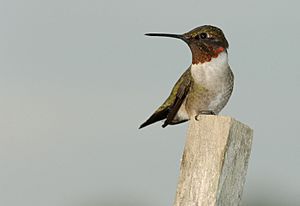
It's hard to count hummingbirds because many live in wild places. But studies in the United States and Canada show that there are about 34 million ruby-throated hummingbirds. There are about 19 million rufous hummingbirds, and about 8 million each of black-chinned, Anna's, and broad-tailed hummingbirds. Some species have much smaller populations, only in the thousands or hundreds.
According to the IUCN Red List in 2024, some hummingbird species are in danger. Eight species are considered critically endangered, 13 are endangered, 13 are vulnerable, and 20 are near-threatened. Sadly, two species, the Brace's emerald and Caribbean emerald, have already become extinct.
Of the 15 hummingbird species in the United States and Canada, some have changed where they live. Others have seen their numbers drop since the 1970s. In 2023, many species were still declining. Rufous, Costa's, calliope, broad-tailed, and Allen's hummingbirds have seen big drops in their numbers. Some have lost as much as 67% of their population since 1970. The ruby-throated hummingbird, which is the most common in North America, saw its population decrease by 17% in the early 21st century.
Several things might be causing these declines. These include losing their habitat, hitting glass windows, being caught by cats, pesticides, and possibly climate change. Climate change can affect their food sources, migration signals, and breeding.
Cool Facts About Hummingbirds
- The bird gets its name from the loud humming sound its wings make when it flies.
- To keep their wings beating so fast, hummingbirds use a lot of energy. It's like a human marathon runner using 10 times the energy they normally would in a day!
- To save energy when food is scarce, hummingbirds can go into a deep sleep called torpor. In this state, their body uses only about 1⁄15 of its normal energy.
- While most hummingbirds don't migrate, the rufous hummingbird makes one of the longest migrations of any bird. It travels about 6,300 kilometers (3,900 miles) twice a year between Alaska and Mexico.
- Hummingbirds have very large eyes compared to their skull size. This gives them excellent eyesight.
- When flying or hovering, a hummingbird's muscle tissue uses about 10 times more oxygen than an elite human athlete's muscles.
- Hummingbirds drink nectar with their long tongues. Their tongues have special tubes that quickly lap up the nectar.
- Hummingbirds are the only birds that can fly backward!
- Anna's hummingbird is the official city bird of Vancouver, British Columbia, Canada.
Images for kids
-
A color plate illustration from Ernst Haeckel's Kunstformen der Natur (1899), showing a variety of hummingbirds
-
Hummingbird theme on the Caribbean Airlines Boeing 737
-
Nest with two eggs in San Jose, California
See also
 In Spanish: Colibríes para niños
In Spanish: Colibríes para niños


